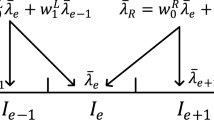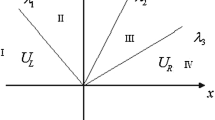Abstract
In recent years, machine learning has been used to create data-driven solutions to problems for which an algorithmic solution is intractable, as well as fine-tuning existing algorithms. This research applies machine learning to the development of an improved finite-volume method for simulating PDEs with discontinuous solutions. Shock-capturing methods make use of nonlinear switching functions that are not guaranteed to be optimal. Because data can be used to learn nonlinear relationships, we train a neural network to improve the results of a fifth-order WENO method. We post-process the outputs of the neural network to guarantee that the method is consistent. The training data consist of the exact mapping between cell averages and interpolated values for a set of integrable functions that represent waveforms we would expect to see while simulating a PDE. We demonstrate our method on linear advection of a discontinuous function, the inviscid Burgers’ equation, and the 1-D Euler equations. For the latter, we examine the Shu–Osher model problem for turbulence–shock wave interactions. We find that our method outperforms WENO in simulations where the numerical solution becomes overly diffused due to numerical viscosity.












Similar content being viewed by others
Notes
Note that the error oscillates between two different values because in the exact solution the discontinuity switches between being on the edge of a cell and 1/3 of a cell width away from either the left or right of a cell edge since the CFL number is 2/3. To get a smooth curve, we apply a filter to the error and plot \(E(i) = \frac{e(i)+e(i-1)+e(i-2)}{3}\).
References
Bar-Sinai, Y., et al.: Learning data-driven discretizations for partial differential equations. Proc. Natl. Acad. Sci. 116(31), 15344–15349 (2019)
Borges, R., et al.: An improved weighted essentially non-oscillatory scheme for hyperbolic conservation laws. J. Comput. Phys. 227(6), 3191–3211 (2008)
Castro, M., Costa, B., Don, W.S.: High order weighted essentially non-oscillatory WENO-Z schemes for hyperbolic conservation laws. J. Comput. Phys. 230(5), 1766–1792 (2011)
Chollet, F. et al.: Keras. https://keras.io (2015)
Chu, C.K.: Numerical methods in fluid dynamics. In: Advances in Applied Mechanics, vol. 18. Elsevier, Amsterdam, pp. 285–331 (1979)
Dissanayake, M.W.M.G., Phan-Thien, N.: Neural-network-based approximations for solving partial differential equations. Commun. Numer. Methods Eng. 10(3), 195–201 (1994)
Fang, J., Li, Z., Lu, L.: An optimized low-dissipation monotonicitypreserving scheme for numerical simulations of high-speed turbulent flows. J. Sci. Comput. 56(1), 67–95 (2013)
Gottlieb, S., Shu, C.W.: Total variation diminishing Runge–Kutta schemes. Math. Comput. Am. Math. Soc. 67(221), 73–85 (1998)
Ha, Y., et al.: An improved weighted essentially non-oscillatory scheme with a new smoothness indicator. J. Comput. Phys. 232(1), 68–86 (2013)
Harten, A.: High resolution schemes for hyperbolic conservation laws. J. Comput. Phys. 49(3), 357–393 (1983)
Harten, A. et al.: Uniformly high order accurate essentially non-oscillatory schemes, III. In: Upwind and High-Resolution Schemes. Springer, Berlin, pp. 218–290 (1987)
Hsieh, J.T. et al.: Learning neural PDE solvers with convergence guarantees. In: arXiv preprint arXiv:1906.01200 (2019)
Jiang, G.S., Shu, C.W.: Efficient implementation of weighted ENO schemes. J. Comput. Phys. 126(1), 202–228 (1996)
Kim, C.H., Ha, Y., Yoon, J.: Modified non-linear weights for fifth-order weighted essentially non-oscillatory schemes. J. Sci. Comput. 67(1), 299–323 (2016)
Kim, J.W., Lee, D.J.: Optimized compact finite difference schemes with maximum resolution. AIAA J. 34(5), 887–893 (1996)
Kingma, D.P., Ba, J.: Adam: a method for stochastic optimization. In: arXiv preprint arXiv:1412.6980 (2014)
Lagaris, I.E., Likas, A., Fotiadis, D.I.: Artificial neural networks for solving ordinary and partial differential equations. IEEE Trans. Neural Netw. 9(5), 987–1000 (1998)
Lele, S.K.: Compact finite difference schemes with spectral-like resolution. J. Comput. Phys. 103(1), 16–42 (1992)
LeVeque, R.J., et al.: Finite Volume Methods For Hyperbolic Problems, vol. 31. Cambridge University Press, Cambridge (2002)
Li, G., Qiu, J.: Hybrid weighted essentially non-oscillatory schemes with different indicators. J. Comput. Phys. 229(21), 8105–8129 (2010)
Liu, Y.: Globally optimal finite-difference schemes based on least squares. Geophysics 78(4), T113–T132 (2013)
Peer, A., Dauhoo, M.Z., Bhuruth, M.: A method for improving the performance of the WENO5 scheme near discontinuities. Appl. Math. Lett. 22(11), 1730–1733 (2009)
Pfau, D. et al.: Spectral inference networks: unifying deep and spectral learning. In: arXiv preprint arXiv:1806.02215 (2018)
Rathan, S., Raju, G.N.: A modified fifth-order WENO scheme for hyperbolic conservation laws. Comput. Math. Appl. 75(5), 1531–1549 (2018)
Rathan, S., Raju, G.N.: Improved weighted ENO scheme based on parameters involved in nonlinear weights. Appl. Math. Comput. 331, 120–129 (2018)
Shu, C.W.: Essentially non-oscillatory and weighted essentially nonoscillatory schemes for hyperbolic conservation laws. In: Advanced numerical approximation of nonlinear hyperbolic equations. Springer, Berlin, pp. 325–432 (1998)
Shu, C.W.: High-order finite difference and finite volume WENO schemes and discontinuous Galerkin methods for CFD. Int. J. Comput. Fluid Dyn. 17(2), 107–118 (2003)
Tam, C.K., Webb, J.C.: Dispersion-relation-preserving finite difference schemes for computational acoustics. J. Comput. Phys. 107(2), 262–281 (1993)
Wang, Z.J., Chen, R.F.: Optimized weighted essentially nonoscillatory schemes for linear waves with discontinuity. J. Comput. Phys. 174(1), 381–404 (2001)
Yu, J., Hesthaven, J.S., Yan, C.: A data-driven shock capturing approach for discontinuous Galerkin methods. Tech. rep. (2018)
Zhang, J.H., Yao, Z.X.: Optimized explicit finite-difference schemes for spatial derivatives using maximum norm. J. Comput. Phys. 250, 511–526 (2013)
Author information
Authors and Affiliations
Corresponding author
Ethics declarations
Conflict of interest
The authors declare that they have no conflict of interest.
Additional information
Communicated by Steven L. Brunton.
Publisher's Note
Springer Nature remains neutral with regard to jurisdictional claims in published maps and institutional affiliations.
This material is based upon work supported by the National Science Foundation Graduate Research Fellowship under Grant No. 1745301.
Rights and permissions
About this article
Cite this article
Stevens, B., Colonius, T. Enhancement of shock-capturing methods via machine learning. Theor. Comput. Fluid Dyn. 34, 483–496 (2020). https://doi.org/10.1007/s00162-020-00531-1
Received:
Accepted:
Published:
Issue Date:
DOI: https://doi.org/10.1007/s00162-020-00531-1




